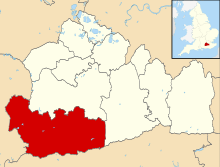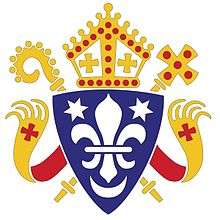St John's Seminary, Wonersh
| St. John's Seminary, Wonersh | |
|---|---|
 St John's Seminary Seen through the trees from the path descending Barnett Hill. | |
 St. John's Seminary, Wonersh Location of St. John's Seminary in Surrey, UK | |
| Coordinates: 51°11′45″N 0°32′7″W / 51.19583°N 0.53528°W | |
| OS grid reference | TQ0246545073 |
| Location | Wonersh, Surrey |
| Country | UK |
| Denomination | Roman Catholic |
| History | |
| Founded | 1889 |
| Founder(s) | Bishop John Butt |
| Dedication | Sacred Heart |
| Consecrated | 1896 |
| Associated people | Francis Bourne |
| Architecture | |
| Status | Theological College |
| Functional status | Active |
| Heritage designation | Grade II Listed |
| Designated | 28 October 1986 |
| Architect(s) | Frederick Walters |
| Style | Dutch Jacobean |
| Groundbreaking | 1889 |
| Completed | 8 September 1891 |
| Administration | |
| Parish | St. Thomas More, Bramley |
| Deanery | Guildford |
| Diocese | Arundel and Brighton |
| Province | Southwark |
| Clergy | |
| Bishop(s) | Rt Rev Richard Moth |
| Rector | Rev Mgr Canon Jeremy Garratt |
St. John's Seminary in Wonersh, Guildford, in the Roman Catholic Diocese of Arundel and Brighton, United Kingdom, is the principal seminary for the Archdiocese of Southwark, and the Diocese of Arundel and Brighton. Other dioceses also make use of it to a greater or lesser extent, including Diocese of Plymouth, Portsmouth, East Anglia, Clifton, Menevia, the Archdiocese of Cardiff and the newly founded Ordinariate of Our Lady of Walsingham.
While it serves mainly dioceses of the South of England, it also provides formation for students from dioceses further afield and for members of religious institutes.
Since 1985 it has also offered courses in theology for lay (external) students. These courses now run alongside the academic programme offered to students in formation. This programme is validated by St. Mary's University College in Twickenham, of which the seminary is an Associated Institution.
The Seminary is also a valuable resource for the local church, and provides a venue for various groups including the formation programme for the Permanent Diaconate, as well as a centre of expertise in the work of formation and sacred science.
History
St John's Seminary was the brainchild of Bishop John Baptist Butt (1826-1899), the fourth bishop of the Diocese (now Archdiocese) of Southwark. He desired to found a college along entirely different, continental, lines, in distinction to the more Jesuit-inspired tradition of the English seminaries to date. He employed as his first rector the young priest Francis Bourne, later to become Cardinal Archbishop of Westminster, who had studied at the great seminary of St Sulpice in Paris and had also known St John Bosco. The project began almost immediately; a site was purchased at Lostiford, a hamlet outside the village of Wonershh near Guildford, and during the two years that the seminary was under construction, the community began in Henfield Place, a large house (still standing) in Henfield, Sussex. Butt was determined that his foundation should be built entirely anew. Therefore, those men already studying for the Southwark Diocese were left in their current seminaries, and only boys were taken for the new St John's Seminary, some as young as twelve. These were to complete their studies in the humanities at St John's before proceeding to the study of Theology at about the age of 17 or 18. In September 1891, the buildings at Wonersh were complete enough to be able to house the new community, though the chapel had not yet been built (this was to follow in 1896). In 1893 there were enough young men ready to study theology, and so from this period St John's housed both a junior and a senior seminary.
In 1896, Francis Bourne was made coadjutor bishop of Southwark only a few weeks after his 35th birthday, and not long afterwards succeeded absolutely to the see when Bishop John Baptist Butt retired. He was succeeded as Rector by George Barrett, who suffered from ill-health and resigned in 1901, to be succeeded by the nephew of the founder, and later Auxiliary Bishop in Westminster, Joseph Butt.
This was a turbulent time for the Seminary, as for the Church. Modernism had begun to appear, and received a certain amount of support from some of the lecturers and students. Bourne, while bishop, was inclined to be mildly tolerant of this, but his successor, Peter Amigo, was not. Amigo had succeeded in 1903, when Bourne was surprisingly made Archbishop of Westminster. Amigo removed several of the lecturers inclined towards modernism, and his stance was proved to have been the politically right one, for the encyclicals of Pope St Pius X Pascendi and Lamentabili were to condemn Modernism in no uncertain terms.
Joseph Butt left Wonersh in 1907, to be succeeded by Arthur Doubleday, later bishop of Brentwood. Bourne had desired that Thomas Hooley, the 'regent' (or superior of the junior seminarians) should have been the successor, and the row between Bourne and Amigo over this subject led to their irreparable falling-out. With justice, Amigo knew that Wonersh was the seminary of his diocese, and that Bourne should, simply, mind his own business. Doubleday was a very strong character, and had every need of his strength to guide the seminary through the troubles of the First World War. Many of the junior seminarians were called up after 1916, and some were sent to the front. As a consequence, the seminary slowly emptied, having only the too old, the too young and the too unfit within its walls.
After the war, the seminary recovered well. In 1924, it was becoming so full that the decision was made to establish a new junior seminary, which became St Joseph's College, Mark Cross near Crowborough in Sussex, and make St John's simply a senior college, something that it has remained ever since. In the same year, Monsignor Philip Hallett became rector; the longest and perhaps the most successful rectorate in the history of the college.
The Second World War was not so devastating as the First at Wonersh. No students were called up; instead, they 'did their bit' locally, participating enthusiastically in various civil defence operations, including operating a local fire service.
Following the war, the advent of a large number of demobbed servicemen to the seminary was considered to have caused considerable disciplinary problems, which were resolved by the stern government of Mgr Bernard Wall in the 1950s. He was to be another future Bishop of Brentwood.
Though St John's had always been considered the strictest of the English seminaries, the aftermath of the Second Vatican Council brought considerable relaxation. Students were encouraged to work in parishes, and live a less monastic life than heretofore. Links with universities; first Southampton, then Surrey, and now St Mary's Twickenham enabled the students to qualify for a degree.
In recent days, there has been a certain amount of anxiety over the Seminary's future, particularly in the light of the closure of St Cuthbert's College, Ushaw. However, things seem fairly secure for the present, and the college is busy making plans for the future.
Senior staff
There are 8 academic staff in residence, all of whom are diocesan priests:
- The Rector, Monsignor Canon Jeremy Garratt
- The Director of Spirituality, Father Gerard Bradley
- The Director of Human Formation, Father Brian Coyle
- The Director of Studies, Father Jonathan How
- Professor of Theology, Father Stephen Dingley
Director of Fifth Year Studies, Father Ty Williams
Motto
The motto spes messis in semine (the hope of the harvest is in the seed), speaks of confidence in the work done at the Seminary for the future of the Church and the Kingdom of God.
Further Reading
- Finnegan, Seán In Hope of Harvest: A History of St John's Seminary.
External links
| Wikimedia Commons has media related to St John's Seminary, Wonersh. |

